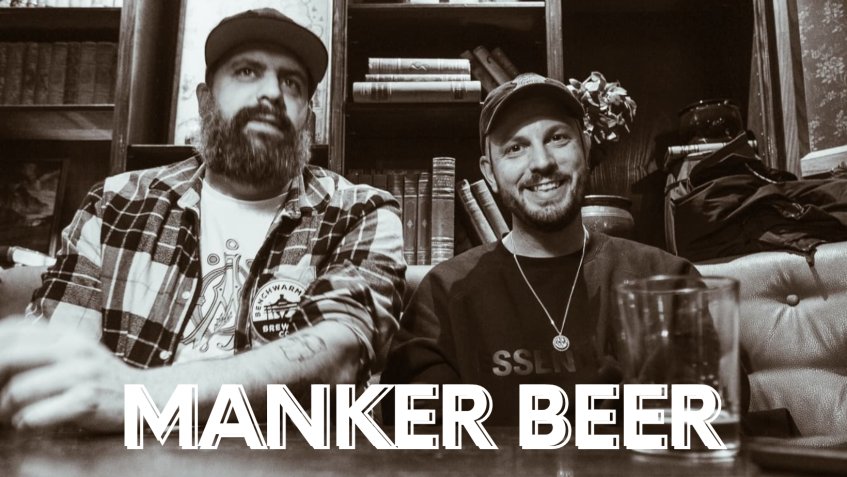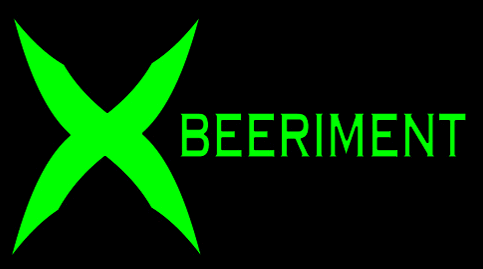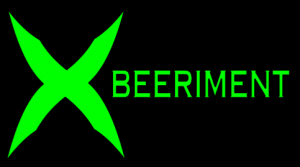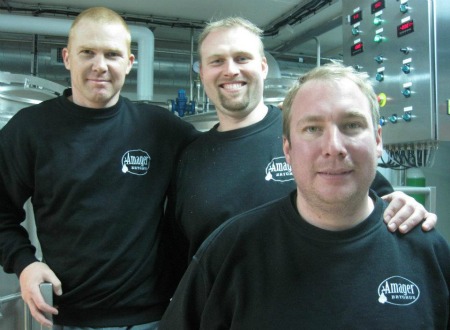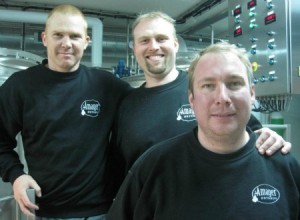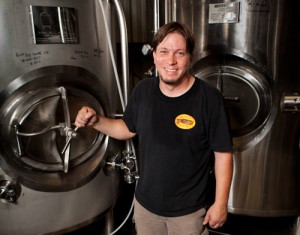
Photo: SeriousEats.com
At last year’s Copenhagen Beer Celebration one of the best stands, according to me, was the one all the way in the back where breweries like Westbrook, Farmer’s Cabinet and Cigar City could be found. Not much of a surprise as we Scandinavians aren’t too spoiled with beers from either of them. For CBC 2013 two of the three are coming back (Westbrook and Cigar City) and there were cheers coming from all over the beer community when the CBC crew announced that Cigar City was coming back. The brewery are sending over head brewer Wayne Wambles to spread some of Florida’s best beery love and as the brewery are expanding into the restaurant business and are establishing plans to produce mead and cider we took the opportunity to see what he would be bringing to CBC and what is happening over at the brewery in Tampa.
MankerBeer (MB): Wayne, how would you present Cigar City for someone new to craft beer?
Wayne Wambles (WW): Cigar City Brewing is a brewery that embraces its surrounding culture and environment. Their beers often have tropical fruit notes and/or tell the story of the history of the surrounding area, which is Tampa, Florida. Ybor city has a rich history of hand rolled cigars. In the 1880’s, cigar manufacturers attracted thousands of immigrants from Spain, Cuba and Italy, which rolled millions of cigars for the next fifty years. The city of Tampa became referred to as the Cigar City.
The brewery also uses items like Cuban espresso and guava in their beers. Cafe con leche, which is made from Cuban roast espresso and scalded milk, is a drink that was popularized by Cuban immigrants. Cigar City produces a sweet stout with this same coffee roast. Another Cuban import is the guava pastry. The brewery uses guava in one of their saisons.
Finally, the brewery doesn’t limit its concepts to strictly local culture. It intends to be more diverse by making beers like Hunahpu’s Imperial Stout. This beer is a transplant from central America. Hunahpu is the Mayan god that gave chocolate to the Mayan people. This beer is a fusion of culinary and zymurgy. It blends the religious and culinary concepts of the Maya with modern day mole and the Holy Trinity of chili peppers. Mole is a secret sauce made from a combination of chocolate, chilis and spices. The Holy Trinity is a combination of ancho, guajillo and pasilla chilis, which is used in the beer as well as Peruvian cacao nibs, Madagascar vanilla beans and Ceylon cinnamon. The Mayan culture made the first chocolate drinks using meticulously hand ground cacao nibs, chili peppers and spices.
Cigar City Brewing paints a vivid picture of history and culture infused with culinary on a canvas of zymurgy.
MB: After working for almost six years at Buckhead Brewery & Grill and then at Foothills Brewing for a little over a year you joined Cigar City in 2008 (march 24 if I got my facts straight). What experiences and lessons have you brought with you from your past employments?
WW: Buckhead Brewery is where I was allowed a great deal of initial creative freedom. This is the brewery where I solidified most of my recipe formulation for traditional beer styles. I also was constantly experimenting with different raw materials…hops, hop extracts and many specialty grains, as well as yeast strains. This chain of brew pubs went through a fairly rapid expansion that I was a part of several times. This allowed me to see what kind of issues one has to face when constructing a brewery.
Foothills allowed me the first view of a hybrid facility. It was a production facility and a brew pub that was also self distributing. I learned many things about self distribution but could not apply them to my experience at Cigar City because Florida is limited to the three tier law. Raw material purchase strategy and hop allocation were things that I discussed and attempted to harness during my time in North Carolina.
To be quite honest with you, there were many things that I wasn’t prepared for when I left North Carolina to work at Cigar City but I promised myself one thing. I constantly reminded myself that this opportunity was a “do or die” situation and I pursued it that way to the best of my ability. I might not have always made the best decisions but I’m still breathing so I guess that I managed things fairly well.
MB: Many of your most sought after beers are only made in small batches, poured only at the brew pub or sold locally. What is the Cigar City brewing capacity and how do you handle the demand on some of the beers?
WW: Our current brewing capacity is around 25,000-30,000 bbls a year. That is a decent chunk of beer. It is a little more complicated than you think, however. Allow me to explain.
In 2009, we sold beer for the first time. There was some consumer demand in the local market but we found that we had extra beer. Our first market outside of Florida was New York. They embraced our brands. All was good.
Next, we went into Philly. They also liked what we were doing with our product and would have taken more.
Shortly afterwards, we brewed a collaboration with Mikkel at Cigar City Brewing, thus developing a relationship with Mikkel and Jeppe. Henrik was also involved and began to import our beer to Denmark and spread it throughout Europe.
Slowly, year after year, our home market of Florida was demanding more product. The locals were finding our brand and seeking it out. The demand became so great that we could no longer supply the consumer demand in the state of Florida. This, in turn, forced us to pull our beer out of all other markets, even the panhandle of Florida, and focus heavily on our local market.
In the last month or so, we have moved back into the panhandle of Florida again but we currently have no plans to distribute outside of Florida anytime soon. That is the grand scheme of things but I don’t think that answers your question.
We believe in making solid base beers. A solid base beer allows us to add many things to one beer and develop different concepts inside of a single brand. There is a branch of the brewery that works on development of small volumes of beer that is just for the tasting room. They don’t make the beer but rather use existing beer to create blends and variations of different brands. We take these beers and sell them at the tasting room to see how the consumer responds to them. It allows us to take a little more risk at minimal waste of product should we make a bad blend.
That is why these beers are more limited.
MB: What brewing style would you say you personally have and how well does it mirror the beers Cigar City produce? When at home, what would your personal pick for the evening be?
WW: I have gone through multiple stages of approaches to brewing.
Initially, I wanted to learn as much as I could about raw materials and process. Then, I moved on to trying to identify and produce examples of various styles of beer, which is probably the stage that I dedicated more time to than any other thus far. I still like to use the style approach occasionally but I also attempt to bend that style into my personal interpretation. That can sometimes evolve into something that is very different than it was in the beginning of the process.
I also attempt to bond with the concept of the brewery. As I have stated above, I feel like tropical notes in many of our different styles is just one of the many things that I can do to breathe life into our concept and make it tangible for the consumer. We live in the subtropics with water and tropical flora all around us. I feel that it should be present in our beer as well.
I also feel that there is a rustic element based on the history of cigars, the immigrants that performed that function and the cigar in general. I have approached this in several ways. We have used Spanish cedar, the wood used in the construction of humidors for cigar storage, to age our beers on. This provides forward notes of white grapefruit and more subtle notes of white pepper, sandalwood and clove. The use of chili peppers and dark malts can also add rustic notes like tobacco and leather.
My personal pick for the evening would be Jai Alai IPA. I drink it more than any other brand that we produce. I designed it to fit our concept and as a result it is one of my favorite beers on the planet.
MB: You brew classic styles but often with a twist – either in the form of cucumber extract in the saison, baseball bats in the IPA or mint in the brown ale. Where does this experimental gene come from?
WW: Every single one of the above examples weren’t my ideas.
The cucumber concept came from an event that we were doing with a martini bar that specialized in cucumber martinis. We decided to take a sessionable saison and add cucumber essence(essence is different than extract…it is distillate of the actual cucumber with no alcohol added…it’s a concentrated version of real cucumber) and the result was a Summer hit. We brewed five or six more batches than we planned during the Summer of 2012. It has become an official Summer seasonal now.
The baseball bats are part of a nonprofit organization called Operation Homefront. It is for a great cause. They supply financial support to the families of soldiers that never came home and to wounded soldiers. The sales of the beer are donated to this cause and the baseball bats that the beer ages on are auctioned to the public to raise even more money for this organization. We participated in this last year and we are proudly returning to participate again this year.
Finally, the mint brown ale was a small volume beer that we blended for Christmas one year.
The cucumber beer and the mint beer were both developed by the same department that makes all the small volume beers that are featured exclusively in our tasting room. We refer to that branch as the “Treatment Department”.
My creativity started with cooking and then moved towards brewing. I worked in restaurants and bars for many years(from the age of 15-25). It taught me the importance of the knowledge and quality of raw materials. I also learned that process can make a big difference in final product. Perhaps one of the most important things, I was constantly exposed to many cultures, having worked in Mexican, Greek, Italian and many other types of concepts. Having that breadth of contact allowed me to explore global possibilities.
MB: Florida has not really been famous for the amount of breweries, but lately it seems as it if starting to change? What does the Florida beer scene look like and why?
WW: The Florida beer scene has been changing for quite some time now.
As I have stated above, most of Florida has this tropical feel. South Florida also grows many exotic and tropical fruits.
The climate of Florida is warm most of the year. It encourages many consumers to drink lower alcohol beers. As a result of the climate and the access to tropical fruit, a new style of beer has emerged in Florida. We call it Florida Weisse. It is a Berliner-style weisse that is infused with different tropical fruits. When I say fruit, I mean fruit. Lots of it! Many of these beers have so much pectin haze that they will never drop clear. It makes for a refreshing, tropical drink during the warm months(most of the year).
There are a great deal of nanos popping up everywhere. Some of them have rapidly moved to larger production due to the success of their brands. That’s inspiring to many home brewers and that is what continues to fuel the nano movement in Florida.
MB: Johnathan Wakefield brewed some collaboration with you that are now ranked among the top beers of the world, with him opening up his own brewery – is there a chance that we will see collaboration with him again, maybe one that will get bottled?
WW: We brewed another collaboration with him late last year. It was based on the Aguas Frescas concept, which are fresh fruit drinks that are served at Latin restaurants and bodegas. We decided to start a series of beers called the Cervezas Frescas series in which we would use large amounts of fruit to create these concepts as well as consider making versions of Carribean cocktails in the form of beer.
The first beer in this series is called Guanabana. It is a tropical fruit that is also referred to as soursop. It has a flavor similar to a mix of pineapple and strawberry with sour citrus and finishing with a creaminess that resembles coconut and/or banana. The base beer was a higher alcohol version of a pale ale hopped with New Zealand and Australian hops for the tropical fruit notes to tie the base beer to the fruit. It was only available draft.
We are working on another brand to continue the series. So far no plans to bottle any of these beers yet but there is a good possibility that will happen in the future.
MB: On the topic of collaborations and your collaboration with B.Nektar (Camp Braggot Ghost Stories) – our mead loving guest writer Kristopher wanted to ask if you are considering trying that again.
WW: That collaboration took well over two years of planning. We kept pushing it along slowly. The label design took just as long as the recipe. The feds didn’t like the fact that we put the word “meadery” on the label, claiming that it was misleading so we had to drop the title to the name of the meadery and leave it at that.
Our next move with B. Nektar is to make a mead in Michigan. We are currently discussing spontaneous, wild or sour. Not sure what we will end up with.
MB: What does the future hold for Cigar City; any expansions, new markets or crazy beers in the pipeline?
WW: Yes, no and always.
We will max out our fermentation capacity in the new facility this year. That will allow us to produce up to 50,000 bbls annually by the end of year six. This year(the end of year five) should put us in the neighborhood of 30,000 bbls. I’m still amazed when I think about how we were able to obtain regional status in four years.
MB: What should beer fans really not miss at Copenhagen Beer Celebration?
WW: This will be my first year attending. Perhaps I should ask them/you that question.
We are going to be pouring a three year vertical of Hunahpu’s Imperial Stout. I would recommend that to attendees.
Cheers! Looking forward to sharing a beer with all of you!
We thannk Wayne for taking the time to answe all our questions and for giving us a hint of what we can expect from Cigar City in the future. The Hunahpu’s vertical will run over all three sessions (or as long as they last) and as always changes in the below line-up may occur and the other three beers will not be poured at all sessions. Go pink!
Cigar City CBC Beer List:
- Hunahpu’s Imperial Stout 2011
- Hunahpu’s Imperial Stout 2012
- Hunahpu’s Imperial Stout 2013
- Humidor Black IPA.
- Cheers.
- Jai Alai
 Another day in paradise and another set of beers being announced for Copenhagen Beer Celebration. In two weeks time I’ll be sitting in Copenhagen drinking beer, longing for CBC to start and to wake up to a day of witnessing some world class brewing (more on that later). So I thought it might be about time to announce some more beers? Except for Denmark the only Nordic country (however, Xbeeriment do have a collaboration with Swedish brewery Brekeriet, Bretty Boop) participating at CBC is Norway. Norway is sending one of their best breweries, Lervig and their friendly brewmaster Mike Murphy. We had a chat with Mike last year and some of what he said is probably still as interesting and will give you an idea of what Lervig is about. If you prefer the full interview you can find it here. At the bottom you find what Lervig is sending to Copenhagen – Bam!
Another day in paradise and another set of beers being announced for Copenhagen Beer Celebration. In two weeks time I’ll be sitting in Copenhagen drinking beer, longing for CBC to start and to wake up to a day of witnessing some world class brewing (more on that later). So I thought it might be about time to announce some more beers? Except for Denmark the only Nordic country (however, Xbeeriment do have a collaboration with Swedish brewery Brekeriet, Bretty Boop) participating at CBC is Norway. Norway is sending one of their best breweries, Lervig and their friendly brewmaster Mike Murphy. We had a chat with Mike last year and some of what he said is probably still as interesting and will give you an idea of what Lervig is about. If you prefer the full interview you can find it here. At the bottom you find what Lervig is sending to Copenhagen – Bam!